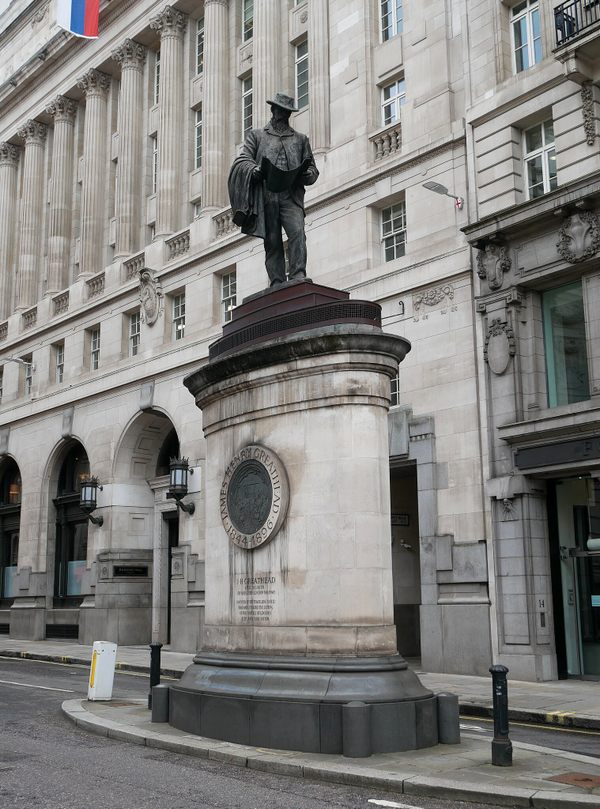The statue of James Henry Greathead stands in the middle of the street near both the Bank of London and the Royal Exchange, one of the most prominent locations in the City of London. Greathead was a 19th-century civil engineer who perfected a method for constructing the deep underground tunnels that are now part of the London Underground. He’s widely regarded as one of the great British engineers of his era. And this statue is not just a monument to Greathead’s achievements—it has a literal connection to the transportation system he helped build.
Greathead’s technique for digging tunnels involved building them in segments. To begin a segment, a wide metal cylinder that was the width of the tunnel (which would later be named the Greathead Shield) was pushed through the underground layers of clay. This shield protected the tunnel from collapsing inwards as it was dug. Next, workers would remove the clay within the cylinder and construct the tunnel’s walls. When a segment was complete, the shield would be pushed forward so workers could start digging the next section of the tunnel.
Greathead first applied this technique to construct the (now-closed) Tower Subway, a pedestrian tunnel joining Tower Hill to Southwark, in 1869-1870. Later, in the 1880s, he would use the technique to create what is now the Bank Branch of the London Underground’s Northern Line. Since Greathead’s death in 1896, people have continued using his techniques to build tunnels in the London area and around the world.
As remarkable as James Henry Greathead’s story is, however, the history alone doesn’t make this statue notable. The monument also has a hidden function as a ventilation shaft.
In 1987, a severe fire at King’s Cross prompted the London Underground to review the fire safety of their network, and one of the recommendations was to install more ventilation shafts along the lines. Several lines converge at Bank Station, but nobody wanted to place a utilitarian vent directly in front of the Bank of England, the Royal Exchange, or any of the other historic buildings in the area. A compromise was reached where the vent would be placed in the center of the street named Cornhill, but it would be capped with a statue help it blend in with the surrounding cityscape.
Civil authorities decided to create a statue of James Henry Greathead, as he was a notable (and relatively uncontroversial) individual connected with the creation of the London Underground. The ventilation shaft was built in the early 1990s, and the statue hiding the vent was unveiled in 1994. Visitors to the area today may stop to look at the statue and spend some time reading the caption at the base of the statue’s plinth about how Greathead helped to construct the Underground, but few may notice the openings to the ventilation shaft in the metalwork just above the top of the plinth.
Know Before You Go
The statue of James Henry Greathead stands in the middle of the street named Cornhill just south of the neoclassical front façade of the Royal Exchange and just east of where Bank Station is usually marked on maps (underneath the multi-street intersection between Cornhill, Lombard Street, Poultry, Princes Street, and Threadneedle Street). As it is a public statue, it can be viewed at any time of day, and as Cornhill only has one lane for each direction of traffic, it is easy to view the statue and search for the air vent openings from either side of the street.
The area can (naturally) be reached by the London Underground with little difficulty, as several lines converge on Bank Station and the connected Monument Station. Additionally, many public buses pass through the area, and some even drive past the statue itself.

